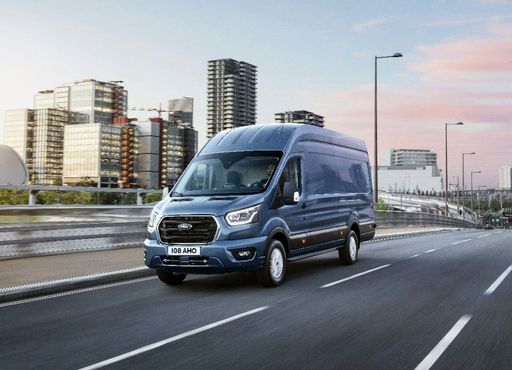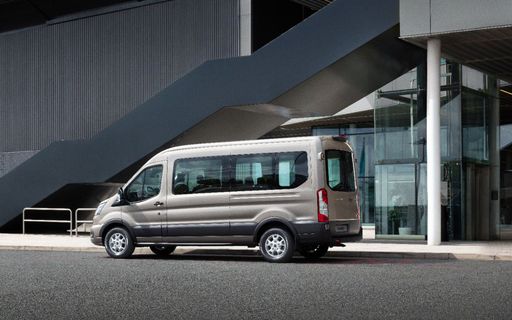Citroen Jumper vs Ford Transit Transporter - Differences and prices compared
Compare performance (279 HP vs 269 HP), boot space and price (55100 £ vs 39900 £) at a glance. Find out which car is the better choice for you – Citroen Jumper or Ford Transit Transporter?
Costs and Efficiency:
Price and efficiency are key factors when choosing a car – and this is often where the real differences emerge.
Ford Transit Transporter has a evident advantage in terms of price – it starts at 39900 £, while the Citroen Jumper costs 55100 £. That’s a price difference of around 15147 £.
In terms of energy consumption, the advantage goes to the Ford Transit Transporter: with 21.30 kWh per 100 km, it’s noticeable more efficient than the Citroen Jumper with 26.20 kWh. That’s a difference of about 4.90 kWh.
As for range, the Citroen Jumper performs hardly perceptible better – achieving up to 424 km, about 22 km more than the Ford Transit Transporter.
Engine and Performance:
Power, torque and acceleration are the classic benchmarks for car enthusiasts – and here, some clear differences start to show.
When it comes to engine power, the Citroen Jumper has a minimal edge – offering 279 HP compared to 269 HP. That’s roughly 10 HP more horsepower.
In terms of top speed, the Citroen Jumper performs slight better – reaching 130 km/h, while the Ford Transit Transporter tops out at 120 km/h. The difference is around 10 km/h.
There’s also a difference in torque: Ford Transit Transporter pulls barely noticeable stronger with 430 Nm compared to 410 Nm. That’s about 20 Nm difference.
Space and Everyday Use:
Beyond pure performance, interior space and usability matter most in daily life. This is where you see which car is more practical and versatile.
Seats: Ford Transit Transporter offers convincingly more seating capacity – 6 vs 3.
In curb weight, Ford Transit Transporter is distinct lighter – 2074 kg compared to 2865 kg. The difference is around 791 kg.
In maximum load capacity, the Citroen Jumper performs to a small extent better – up to 17000 L, which is about 2900 L more than the Ford Transit Transporter.
When it comes to payload, Ford Transit Transporter decisively takes the win – 2607 kg compared to 1385 kg. That’s a difference of about 1222 kg.
Who comes out on top?
Overall, the Ford Transit Transporter shows itself to be leaves the rival little chance and secures the title of DriveDuel Champion.
It convinces with the more balanced overall package and proves to be the more versatile choice for everyday use.

Ford Transit Transporter
Costs and Consumption
View detailed analysis
Engine and Performance
View detailed analysis
Dimensions and Body
View detailed analysis
Citroen Jumper
The Citroen Jumper is a no-nonsense workhorse that swaps flash for sheer practicality, with a spacious load area and composed, user-friendly driving manners that make busy workdays easier. It won’t win any beauty contests, but its sensible packaging, comfortable cab and wallet-friendly running make it a compelling choice for tradespeople and small businesses.
detailsFord Transit Transporter
The Ford Transit is the no-nonsense workhorse that turns heavy-duty hauling into a surprisingly civilized experience, with a cabin that favors practicality over pretense. It’s the go-to for tradespeople and fleet managers who want reliability, adaptability and low running headaches — not showy gimmicks.
details



|
|
|
|
|
Costs and Consumption |
|
|---|---|
|
Price
55100 - 57800 £
|
Price
39900 - 73000 £
|
|
Consumption L/100km
-
|
Consumption L/100km
7.9 - 10.3 L
|
|
Consumption kWh/100km
26.20 kWh
|
Consumption kWh/100km
21.3 - 32 kWh
|
|
Electric Range
424 km
|
Electric Range
247 - 402 km
|
|
Battery Capacity
97.80 kWh
|
Battery Capacity
68 kWh
|
|
co2
0 g/km
|
co2
0 - 270 g/km
|
|
Fuel tank capacity
-
|
Fuel tank capacity
70 L
|
Dimensions and Body |
|
|---|---|
|
Body Type
Cargo Van
|
Body Type
Cargo Van
|
|
Seats
3
|
Seats
3 - 6
|
|
Doors
4
|
Doors
4
|
|
Curb weight
2865 - 2940 kg
|
Curb weight
2074 - 2765 kg
|
|
Trunk capacity
-
|
Trunk capacity
-
|
|
Length
5998 - 6363 mm
|
Length
5531 - 6704 mm
|
|
Width
2050 mm
|
Width
2059 mm
|
|
Height
2612 - 2850 mm
|
Height
2530 - 2778 mm
|
|
Max trunk capacity
13000 - 17000 L
|
Max trunk capacity
9300 - 14100 L
|
|
Payload
560 - 1385 kg
|
Payload
735 - 2607 kg
|
Engine and Performance |
|
|---|---|
|
Engine Type
Electric
|
Engine Type
Diesel, Electric
|
|
Transmission
Automatic
|
Transmission
Manuel, Automatic
|
|
Transmission Detail
Reduction Gearbox
|
Transmission Detail
Manual Gearbox, Automatic Gearbox, Reduction Gearbox
|
|
Drive Type
Front-Wheel Drive
|
Drive Type
Front-Wheel Drive, Rear-Wheel Drive, All-Wheel Drive
|
|
Power HP
279 HP
|
Power HP
105 - 269 HP
|
|
Acceleration 0-100km/h
-
|
Acceleration 0-100km/h
-
|
|
Max Speed
90 - 130 km/h
|
Max Speed
120 km/h
|
|
Torque
410 Nm
|
Torque
310 - 430 Nm
|
|
Number of Cylinders
-
|
Number of Cylinders
4
|
|
Power kW
205 kW
|
Power kW
77 - 198 kW
|
|
Engine capacity
-
|
Engine capacity
1996 cm3
|
General |
|
|---|---|
|
Model Year
2024
|
Model Year
2019 - 2024
|
|
CO2 Efficiency Class
A
|
CO2 Efficiency Class
G, A
|
|
Brand
Citroen
|
Brand
Ford
|
Is the Citroen Jumper offered with different drivetrains?
Available configurations include Front-Wheel Drive.
The prices and data displayed are estimates based on German list prices and may vary by country. This information is not legally binding.
